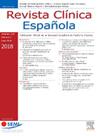2019年新冠肺炎后12个月内放射线变化预测
IF 1.7
4区 医学
Q2 MEDICINE, GENERAL & INTERNAL
引用次数: 0
摘要
背景与目的新型冠状病毒肺炎后影像学进展尚不清楚。我们建议分析COVID-19肺炎一年后的主要影像学表现,并确定可能影响其的因素。材料与方法对COVID-19肺炎患者出院后12个月行高分辨率计算机断层扫描(HRCT)的简短研究。对放射学结果进行描述性研究,并进行多变量分析,以确定放射学异常出现的因素。结果139例患者,平均年龄63岁,男性占66.2%。最常见的影像学表现为毛玻璃混浊(59%),其次是支气管扩张(42.4%)、胸膜下实质带(32.4%)、肺不张(13.7%)、间隔增厚(12.9%)和纤维化束(9.4%)。男性与支气管扩张相关(ORa = 3.55;P= 0.026),峰值入院IL-6水平>;133 ng/L胸膜下实质带检测(ORa = 3.58;p = 0.048),肥胖与肺不张的发生相关(ORa = 3.70;P = .014)。入院时全身皮质治疗可降低纤维化束的风险(ORa = 0.02;P = .003)。结论新型冠状病毒肺炎后1年肺损伤发生率较高。男性、入院时峰值IL-6水平和肥胖是放射学异常的危险因素,而全身皮质类固醇治疗可减少住院后12个月纤维化束的发生。本文章由计算机程序翻译,如有差异,请以英文原文为准。
Predictores de la aparición de alteraciones radiológicas a los 12 meses tras una neumonía por COVID-19
Background and objective
The radiological evolution after COVID-19 pneumonia is unknown. We propose to analyze the main radiological findings one year after COVID-19 pneumonia, as well as identify possible factors that may influence it.
Material and methods
Cohort study of patients with COVID-19 pneumonia undergoing high-resolution computed tomography (HRCT) 12 months after hospital discharge. A descriptive study of the radiological findings and a multivariate analysis are carried out to identify the factors of the appearance of radiological anomalies.
Results
One hundred thirty-nine patients, with a mean age of 63 years and 66.2% male. The most frequent radiological findings were ground-glass opacities (59%), followed by bronchiectasis (42.4%), subpleural parenchymal bands (32.4%), atelectasis (13.7%), septal thickening (12.9%) and fibrotic tracts (9.4%). Male sex was associated with the presence of bronchiectasis (ORa = 3.55; P=.026), peak admission IL-6 levels > 133 ng/L with the detection of subpleural parenchymal bands (ORa = 3.58; p = 0.048) and obesity with the occurrence of atelectasis (ORa = 3.70; P=.014). Systemic corticotherapy during admission decreased the risk of fibrotic tracts (ORa = 0.02; P=.003).
Conclusions
Lung damage persists with high frequency one year after COVID-19 pneumonia. Male sex, high peak admission IL-6 levels and obesity were risk factors for radiological abnormalities while systemic corticosteroid therapy decreased the occurrence of fibrotic tracts 12 months after hospital admission.
求助全文
通过发布文献求助,成功后即可免费获取论文全文。
去求助
来源期刊

Revista clinica espanola
医学-医学:内科
CiteScore
4.40
自引率
6.90%
发文量
73
审稿时长
28 days
期刊介绍:
Revista Clínica Española published its first issue in 1940 and is the body of expression of the Spanish Society of Internal Medicine (SEMI).
The journal fully endorses the goals of updating knowledge and facilitating the acquisition of key developments in internal medicine applied to clinical practice. Revista Clínica Española is subject to a thorough double blind review of the received articles written in Spanish or English. Nine issues are published each year, including mostly originals, reviews and consensus documents.
 求助内容:
求助内容: 应助结果提醒方式:
应助结果提醒方式:


